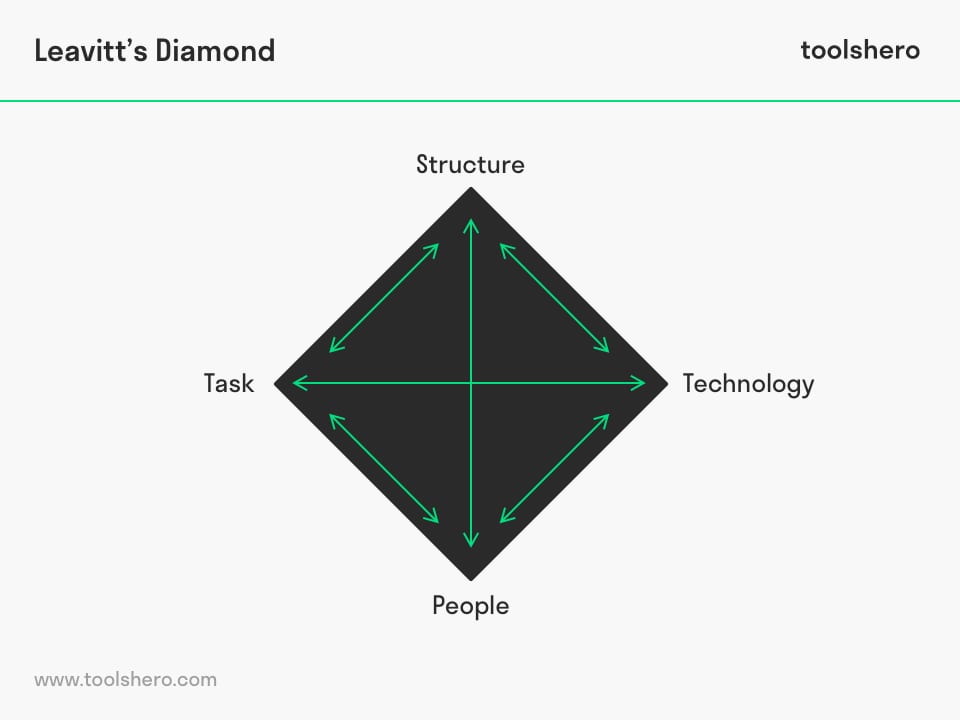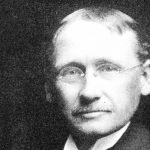Leavitt’s Diamond Change Model explained

Leavitt’s Diamond Model: this article provides a practical explanation of the Leavitt’s Diamond Model, developed by Harold Leavitt. Next to what it is, this artcile also highlights the four Components of the Leavitt’s Diamond Change Model and the Mutual coherence within the model. After reading, you will undertand the basics of this change management model. Enjoy reading!
What is the Leavitt’s Diamond? The theory
Leavitt’s Diamond or the Leavitt Business Diamond is a model that can be applied to and used for change management. It gives insight into a company’s critical success factors and was developed in the early 1970s by the American professor and organisational psychologist Harold Leavitt.
According to the Leavitt Diamond Model, the success factors required to accomplish change are Structure, Tasks, People, and Technology. In the model, these four factors are placed in a square shape and interconnected, thus creating a diamond shape.
This is what the model owes its name to. There are other comparable business models shaped like a diamond, the best known of which are those by Michael Porter and Edward Lawler III.
Leavitt’s Diamond model: four Components
The Leavitt’s Diamond model consists of four components, which Leavitt calls the most important factors in an organisation’s success The four components are mentioned below. Moreover, it is indicated what a particular change in each of them causes in the other three:

Figure 1 – Leavitt’s Diamond model: four Components
1. Structure
Structure is not only about an organisation’s hierarchical buildup and the layout of the various departments. It also involves the mutual relations between departments and employees, the coordination between various levels of management, and communication patterns. These also result in the responsibilities within the organisation. A structure may be changed and adjusted for many reasons. Think of a reorganisation, a partnership, acquisition, or merger; restructuring of product groups, or reduction of management layers. A change in structure always comes with changes in another component or other components of the diamond.
Change in the People component
As soon as the structure changes because of one of the above examples, something will change in the employees as well. Their motivation, participation, and productivity may increase or decrease. On the other hand, a change in employees may in turn influence the structure of the organisation. When deploying highly qualified staff or training the skills of existing staff, less supervision and guidance is needed and managers’ span of control will increase.
Change in the Tasks component
A new organisational structure means different departments and, naturally, different tasks for the staff as well. The working methods and procedures change along with the end goal. Moreover, as soon as new company processes are developed, a number of positions or even levels of management may disappear completely.
Change in the Technology component
As soon as something changes in the area of technology, such as automation, this requires a renovation of organisational structure as well. For example, new positions will be created, and certain work may perhaps be taken over by technology. This will result in a reduced number of positions, along with which the organisational structure will have to change as well. It may also be the case that the coordination between departments will have to be adjusted.
2. Tasks
This component has two parts: on the one hand, those tasks that individual employees are assigned within their jobs; on the other hand, the goals on strategic, tactical, and operational level.
In short, it involves all the things that need to be done in order to achieve a certain goal at the organisational, departmental, or individual level.
Leavitt states that tasks should definitely make qualitative contributions to the organisational goal in the form of productivity and return on investment.
Change in the People component
As soon as there is a change of staff, or employees’ knowledge and expertise changes through training or a specific hiring policy, the individual tasks within their jobs will change as well.
Change in the Structure component
When the organisational structure changes, departments will also be restructured, resulting in a different arrangement of job positions. A different way of working will be expected from employees, which includes different and/or additional tasks. In case of reorganisation, too, the company goal will change, with consequences for each employee’s individual tasks.
Change in the Technology component
A change in technology will often have a great impact within an organisation. It entails that employees will have to work differently, and will receive different tasks.
Certain work will be taken over by technology, which changes the content of the tasks for the staff. For example, manual input will no longer be part of the tasks, whereas digitally adjusting and processing certain information will.
3. People
This refers to all employees within an organisation. Without manpower, there is no productivity and an organisation is unable to function. This component also pertains to all skills, competencies, knowledge, and efficiency that employees bring.
Change in the Tasks component
When tasks change, it directly influences employees. Staff are used to doing what they do and will have to be motivated to carry out different tasks. Moreover, they will also have to be capable of carrying out additional or different tasks. Training and education is often required when new tasks are offered.
Change in the Structure component
A change in organisational structure usually has a restructuring of divisions and positions as its consequence. This means that employees receive different job positions with a new TAR package: tasks, authorities, and responsibilities.
Change in the Technology component
The application of new technology generally requires extensive training for employees, in order for them to be able to work with it as effectively and efficiently as possible. In addition, it may mean new employees are hired, who are already knowledgeable about and experienced with the new technology.
4. Technology
Technology is a broad concept. It is aimed at being able to carry out tasks better, easier, and faster within an organisation. Think, for example, of cloud services, a customer relationship management (CRM) system, and software applications. Upgraded machines and devices fall under this component as well.
Change in the People component
What is the effect of change in the people component of the Leavitt’s Diamond? New technology requires flexibility of employees.
Firstly, it is important for them to know how to work with the new technology. In addition to instruction and training, motivation plays an important role there.
When hiring new staff with specific qualifications, too, it’s a good idea to offer technology to them that can help them carry out their work well.
Change in the Tasks component
Changes to tasks or goals, too, may lead to technological changes. For example, the customer service employee who is given the additional task of carrying out order processing would be aided by the company investing into a well-functioning CRM system.
Change in the Structure component
In case of a reorganisation, it may happen that departments merge or disappear. Nevertheless, productivity should be kept going, and the arrival of an automated technical process is a prerequisite. This way, a call centre will no longer have to be operated by employees, but may operate in part through a computer system and a selection menu.
Mutual coherence within the Leavitt’s Diamond Model
According to Harold Leavitt, all four factors in the Leavitt’s Diamond have mutual interactions, which means they always need to be brought into accordance. Leavitt’s Diamond is an interactive approach, in which the four factors mentioned above are mutually coherent and influence one another.
Leavitt emphasises that whenever a factor changes and influences the organisation, the other three factors will also change. Because of this direct effect, they will also need to be adjusted in order to be able to process the change.
This means the Leavitt’s Diamond model is an integrated approach, and it is often used for managing changes within organisations. It is aimed at behaviour within organisations, the dynamics of organisational change, and the interaction of the four mutually coherent components that apply in each organisation.
The Leavitt’s Diamond may be useful in case of, for example, the introduction of new systems or a change of organisational structure.
Now it’s your turn
What do you think? Do you recognize the explanation of the Leavitt’s Diamond model? What do you think about the 4 components in this model? How do you map critical success factors of a company? Do you have any tips or additional comments?
Share your experience and knowledge in the comments box below.
More information
- Keen, P. G. (1980). Information systems and organizational change.
- Smith, C., Norton, B., & Ellis, D. (1992). Leavitt′ s diamond and the flatter library: a case study in organizational change. Library management, 13(5), 18-22.
- Wigand, D. (2007). Building on Leavitt’s diamond model of organizations: the organizational interaction diamond model and the impact of information technology on structure, people, and tasks. AMCIS 2007 Proceedings, 287.
How to cite this article:
Mulder, P. (2019). Leavitt’s Diamond Change Model. Retrieved [insert date] from Toolshero: https://www.toolshero.com/change-management/leavitts-diamond/
Original publication date: 02/18/2019 | Last update: 08/31/2023
Add a link to this page on your website:
<a href=”https://www.toolshero.com/change-management/leavitts-diamond/”>Toolshero: Leavitt’s Diamond Change Model</a>












